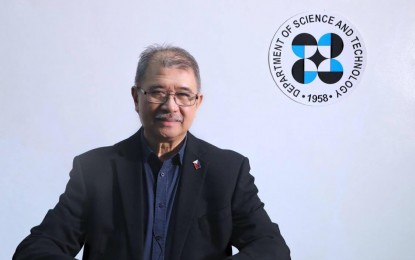
DOST Secretary Fortunato de la Peña (Photo courtesy of DOST)
MANILA – The MULA (Multispectral Unit for Land Assessment) satellite, which is expected to be launched in 2023, is among the Department of Science and Technology's (DOST) priority agenda, Secretary Fortunato de la Peña said on Thursday.
"I am looking forward to how MULA's enhanced imaging capabilities may help improve disaster management, land use and land cover change mapping, crop monitoring and forest monitoring," he said in a virtual event on the Philippine Space Agency's (PhilSA) Facebook page.
Compared to other Filipino-made satellites that were launched in outer space previously, MULA will stay longer and take more images, with its added jet propulsion system.
It is twice as heavy and bigger compared to Diwata-2 microsatellite, with more payloads added, and more spectral bands, capable of more image applications and satellite products.
"MULA is very significant to the DOST. Aside from being the biggest Philippine satellite developed, this is the first satellite that the DOST is doing in coordination with PhilSA," the DOST chief said.
De la Peña is confident in PhilSA's ability to oversee MULA's completion and expected launch, as well as in managing and operating the satellite thereafter.
"It gives me pride to witness firsthand how the DOST's early space R&D (research and development) activities have helped (mold) capable young Filipino scientists and engineers," the official said, adding that the MULA team's dedication serves as an inspiration.
Their dedication, he said, will continue to inspire the next generation of space scientists and engineers.
He said there are 16 engineers involved in the development of MULA, and nine of them have just returned to the Philippines after completing their training in the United Kingdom.
They spent four months of training at the Surrey Satellite Technology Ltd., and have recently completed the preliminary design review, which is a crucial part of MULA's development phase, he said.
Through MULA, Filipino researchers could harness the advanced technology to mitigate challenges such as water quality, marine resources sustainability, among others, using the satellite.
The low earth orbit MULA satellite can go around the globe 10 times daily, which will add opportunities to market data, or as a means to leverage collaboration with other nations. (PNA)
"I am looking forward to how MULA's enhanced imaging capabilities may help improve disaster management, land use and land cover change mapping, crop monitoring and forest monitoring," he said in a virtual event on the Philippine Space Agency's (PhilSA) Facebook page.
Compared to other Filipino-made satellites that were launched in outer space previously, MULA will stay longer and take more images, with its added jet propulsion system.
It is twice as heavy and bigger compared to Diwata-2 microsatellite, with more payloads added, and more spectral bands, capable of more image applications and satellite products.
"MULA is very significant to the DOST. Aside from being the biggest Philippine satellite developed, this is the first satellite that the DOST is doing in coordination with PhilSA," the DOST chief said.
De la Peña is confident in PhilSA's ability to oversee MULA's completion and expected launch, as well as in managing and operating the satellite thereafter.
"It gives me pride to witness firsthand how the DOST's early space R&D (research and development) activities have helped (mold) capable young Filipino scientists and engineers," the official said, adding that the MULA team's dedication serves as an inspiration.
Their dedication, he said, will continue to inspire the next generation of space scientists and engineers.
He said there are 16 engineers involved in the development of MULA, and nine of them have just returned to the Philippines after completing their training in the United Kingdom.
They spent four months of training at the Surrey Satellite Technology Ltd., and have recently completed the preliminary design review, which is a crucial part of MULA's development phase, he said.
Through MULA, Filipino researchers could harness the advanced technology to mitigate challenges such as water quality, marine resources sustainability, among others, using the satellite.
The low earth orbit MULA satellite can go around the globe 10 times daily, which will add opportunities to market data, or as a means to leverage collaboration with other nations. (PNA)
